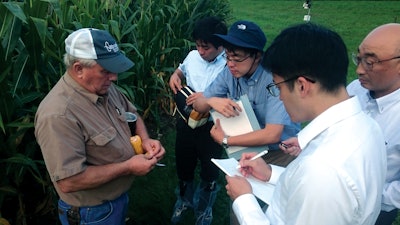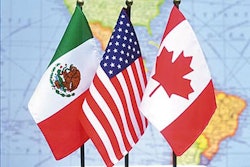
The new U.S.-Japan Trade Agreement that went into effect on January 1, will allow the U.S. grain industry to solidify and build on one of its most important trading relationships.
The U.S. Grains Council (USGC) has worked in the Japanese market for nearly 50 years. USGC has built deep partnerships with some of the largest and most loyal customers of U.S. coarse grains and co-products.
Since opening an office there in 1961, USGC has worked closely with Japanese grain buyers and end-users to develop their industry to serve Japan’s increasing demand for meat, milk and eggs. Today, U.S. farmers and agribusinesses continue to reap the benefits of that work.
Japan ranked as the second-largest market for U.S. grains in all forms in 2018/2019 at 16.7 million metric tons (657 million bushels), valued at $6.3 billion. By commodity, Japan represented the second-largest buyer of U.S. corn, the third-largest buyer of U.S. barley and barley products, the fourth-largest buyer of U.S. sorghum and eighth-largest buyer of U.S. dried distiller’s grains with solubles (DDGS).
Large, loyal corn buyer
Japan’s domestic production of feed grains is still negligible, and the Japanese feed industry has been heavily committed to buying from the U.S. due to the reliability of the corn supply and strong trading relationships. Consistency is necessary, however, to ensure that Japan remains a market.
USGC serves as a bridge between U.S. suppliers and Japanese users, keeping corn users informed about the U.S. crop from planting to harvest to export. Japanese customers appreciate and value personal relationships, so understanding both the crop and the farmer who produces it is an important part of conducting business in Japan.
With growing competition from South America and Eastern Europe over the last decade, USGC has aggressively defended the Japanese market by providing customers with frequent updates and detailed analysis of each year’s crop through annual corn quality reports and crop quality seminars. The efforts highlight the stability and reliability of the U.S. as a corn supplier.
Transparency is another key component of promoting U.S. corn. Even when the market has quality challenges and issues related to weather, logistics or other factors outside producer or export controls, Japanese customers appreciate an open dialogue with in-depth information and answers to questions on specific quality attributes or issues.
USGC participates in every major feed grain conference in Japan, hosts trade teams of Japanese buyers to the U.S. annually, and presents the organization’s corn quality and harvest quality reports to the Japanese feed industry annually.
How sorghum fits
USGC is also continuously working to explore new markets for U.S. coarse grains, including opportunities for food sorghum, in cooperation with the USDA’s Foreign Agricultural Service (FAS). USGC has conducted promotion efforts for white food sorghum and white sorghum flour in the Japanese market over the past few years. As a result, there has been growth in this new niche market leading to new uses for this crop by the Japanese snack and food industry.
Professional Japanese baseball player turned bakery owner Tomohito Yoneno, promoted the nutritional benefits of U.S. food sorghum during a September sports nutrition seminar arranged by USGC at the sixth annual Sports Nutrition Society meeting in Tokyo.
Sorghum is a recommended part of an athletic diet, as it is rich in dietary fiber, resistant starch and mineral content.
U.S. white sorghum, in the form of sorghum flour and the grain itself, was the featured ingredient in the lunch box served to the audience of 150.
Also, during the luncheon’s presentation, Michiyo Hoshizawa, USGC program and administrative manager in Japan, and Reiko Hashimoto, a registered dietitian, discussed the nutritional attributes and cooking characteristics of U.S. sorghum as well as the impact of the ancient grain on athletic performance.
While not large, this specialized market provides another value-added opportunity for U.S. sorghum farmers, especially as Japan prepares to host the Olympic Games in 2020.
Barley fits niche needs
Japanese health awareness has already created a small, but growing, niche market for specific varieties of U.S. food barley containing high levels of beta-glucan, a dietary fiber. Japan imported nearly 30,500 metric tons (1.4 million bushels) of food barley between January and October 2019, up 29% year-over-year. High beta-glucan barley, produced under contract specifically for the Japanese market, is a value-added market for U.S. barley farmers.
To help boost U.S. market share, USGC has partnered with Zenbakruen (All Japan Barley Industry Association) and the Japan Food Barley Promotion Association. Together they promote the heart health benefits of barley with food snack companies and industry associations through educational seminars, trade teams and reverse missions. Based on these continued efforts, the industry now also separately promotes these products in the Japanese market.
To continue capturing market share, USGC regularly facilitates direct conversations between U.S. barley farmers and Japanese end-users and participates in industry events like the Food Barley Symposium in November 2019, organized by the Japanese Council for Food Barley Promotion.
Expanding ethanol
Japan is also increasing demand for U.S. ethanol-based products. The first shipment of ethyl tert-butyl ether (ETBE) made with U.S. corn-based ethanol, 13.5 million gallons representing two million bushels of corn demand, arrived in Japan in July 2019. The shipment of ETBE was made possible following a policy change by the Japanese government recognizing the positive greenhouse gas benefits.
Japan will now allow U.S. ethanol to meet up to 44% of a total estimated demand of 217 million gallons of ethanol used to make ETBE, or potentially 95.5 million gallons of U.S.-produced ethanol annually. Japan imports nearly all ETBE from ethanol.
In recent years, USGC, Growth Energy and the Renewable Fuels Association, corn state associations and the USDA’s Foreign Agricultural Service have worked to show the benefits of U.S. ethanol to Japanese officials and members of the Japanese fuel industry.
USGC will continue to demonstrate the value of U.S. ethanol as a component of ETBE and as an environmentally friendly oxygenate for fuel blending.
New trade agreement
The newly-enacted U.S.-Japan Trade Agreement reflects deep ties built over decades of mutual work across the food, feed and fuel industries. As this agreement moves forward, lowering market access barriers with one of the most valuable U.S. grain buyers is a critical win-win.
In negotiating and approving this agreement, the two countries have built on a long-standing relationship of mutual trust.
The agreement solidifies trade between the two countries by maintaining a zero duty on imports of corn for feed and eliminating a 3% tariff for corn other than feed.
Japan will also eliminate U.S. sorghum tariffs, which are as high as 3%, and reduce a mark-up on barley for feed.
The agreement also includes a staged reduction for U.S. ethanol, corn, barley and sorghum flour, and also preserves duty-free market access for U.S. feed corn, food corn, corn gluten feed and DDGS.
Importantly, these provisions allow U.S. farmers and agribusinesses to compete on a level playing field with competitors in the Comprehensive and Progressive Agreement for Trans-Pacific Partnership and the EU-Japan Economic Partnership Agreement.
USGC is continuing to work with U.S. and Japanese partners as additional discussions take place regarding non-tariff trade barriers and additional market access measures related to ethanol.
Together, these trade policy discussions, new market promotions and regular customer servicing activities are vital to maintaining loyal customers who are knowledgeable about and comfortable with the U.S. as the primary, stable source of high-quality coarse grains and co-products. ■

















